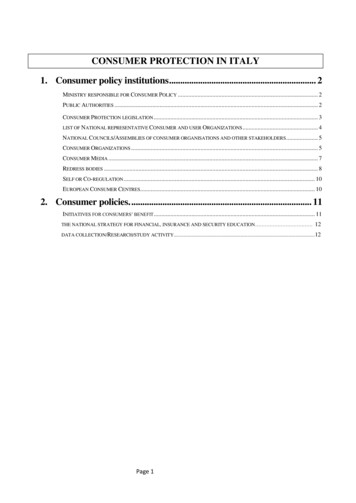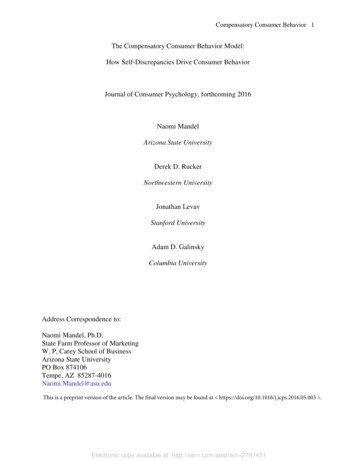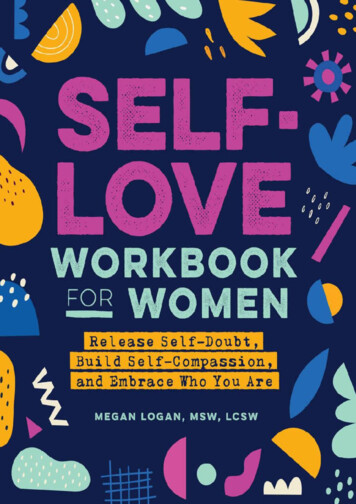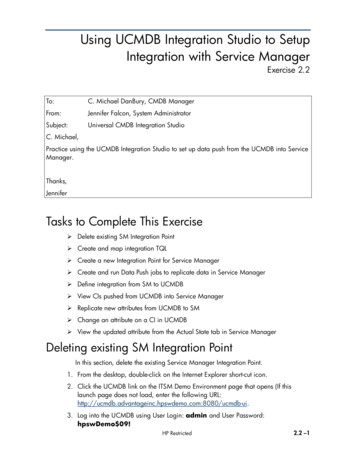
Transcription
3- Consumer Integration and Self-Determination inHomelessness Research, Policy, Planning, andServicesSusan Barrow, PhD, NY State Psychiatric Institute, New York, NYLorraine McMullin, Mental Health Association in New York State, Albany, NYJulia Tripp, Center for Social Policy, University of Massachusetts, Randolph, MASam Tsemberis, PhD, Pathways to Housing, New York, NYAbstractIn this paper, the authors assess how the process and outcomes of research, policy, and service deliverychange when they involve or are driven by people who have themselves experienced homelessness. Theyreview the available evaluation literature and present lessons from the field on consumer integration inresearch, policy, and program implementation. Barriers to consumer integration and strategies foraddressing these barriers are described. Barrow and her colleagues further address what happens whenpeople who are homeless make the decisions about the housing and services they need. They conclude byreviewing findings on the individual- and system-level impacts of consumer-driven approaches tohomeless assistance.IntroductionIn the 35 years since homelessness emerged as a social issue requiring public attention and policyresponses, it has become institutionalized in government and civil structures at all levels. So many federalagencies are affected by issues related to homelessness that an interagency council has been created tocoordinate their efforts. Our largest cities have full-blown homeless services departments; many not-forprofit agencies are wholly or heavily funded by contracts to provide housing and services to people whoare homeless; and a cadre of academics now specialize in homelessness research. Against thisbackground, the new language of “ending homelessness” announces a disruption of business as usual andissues a challenge to decades of conventional wisdom. Among the new approaches commanding attentionare those that claim prominent roles for people who have been homeless—long the objects, but rarely theauthors, of either research, policy, planning, or services developed to address homelessness or their ownhousing and service options.2007 National Symposium on Homelessness Research3-1Disclaimer: This paper was developed for the National Symposium on Homelessness Research held on March 1-2, 2007. TheSymposium was conducted by Abt Associates Inc. and Policy Research Associates Inc. under contract for the Office of theAssistant Secretary for Planning and Evaluation, U.S. Department of Health and Human Services; and the Office of Policy,Development, and Research, U.S. Department of Housing and Urban Development. The paper presents the views and opinions ofthe respective author(s) and does not necessarily represent the views, positions, and policies of the federal government.
Consumer Integration and Self-Determination in Homelessness Research, Policy, Planning, and ServicesThis paper seeks to contribute to this Symposium’s appraisal of knowledge about preventing and endinghomelessness by addressing two questions: How are research, policy, and service delivery processes andoutcomes changed when they involve or are driven by people who have themselves experiencedhomelessness? And what happens when people who are homeless make the decisions about the housingand services they need? Guided by these questions, we offer a synthesis and assessment of availableinformation—some of it in the “fugitive” or “gray” literature of reports, newsletters, conference handouts,and web postings; some in peer-reviewed and published research—reporting on the involvement ofpeople who are or were homeless in research, policy, planning, service delivery, and on consumer-driven,choice-based homeless services.For the purposes of clarity in this paper, we use the term “consumer” to describe individuals who arecurrently or were formerly homeless. The term is controversial for several reasons, including itsconnotation that those experiencing homelessness can shop around for services among several availableoptions as well as its links to an economic language of the marketplace. However, in the literature wereview, it is the term most widely used to refer to people with current or past experiences of homelessnessor those who have received system services. Other terms sometimes used instead of “consumer” in themental health movement include “psychiatrically disabled” (Hensley, 2006) or “survivor” to indicatepeople who consider themselves “disabled” or who have survived psychiatric hospitalization or othertrauma. However, these terms apply less broadly, since not all individuals impacted by homelessness havea history of psychiatric illness or hospitalizations or identify themselves as survivors of trauma. The term“peer” is currently used in the United States to identify people with a collective experience (for example,mental health and/or substance abuse recovery or homelessness) who are working and using theirpersonal experiences and skills to assist others facing the same challenges. When reporting on programsthat use the term “peer” in describing their staffing, we have retained this usage, but because wedocument participation by people who have experienced homelessness in research, policy, and planning,as well as in service delivery, the term “consumer” is a better fit than “peer” with the topic and intent ofmost parts of this paper.Institutional and Policy ContextDecisions about and funding for research, policy, planning, and service delivery occur at national, state, andlocal levels, and are implemented in public, not-for-profit, and private organizational contexts. Severalnational-level government and advocacy organizations, notably the Interagency Council on Homelessnessand the National Alliance to End Homelessness, have now adopted consumer-driven approaches as part oftheir push for 10-year plans to end homelessness, introducing choice-based housing and services in diverselocales. The National Association of State Mental Health Program Directors promotes state-level support forconsumer self-determination of housing and services (NASMHPD, 2005).Within federal departments that make policy and fund homelessness research, housing, and services,some agencies have strongly advocated consumer involvement. In the Department of Health and HumanServices (HHS), the Substance Abuse and Mental Health Services Administration (SAMHSA), whichsupports homeless services for people with mental health and substance problems and evaluatesinnovative approaches, has played a leading role. The Health Resources and Services Administration(HRSA) has set high standards for consumer participation in governance of community health centers,though less stringent standards apply to HRSA-funded Health Care for the Homeless programs. At theNational Institutes of Health (NIH), which fund most academic research on homelessness, consumer3-22007 National Symposium on Homelessness Research
Consumer Integration and Self-Determination in Homelessness Research, Policy, Planning, and Servicesinvolvement has not been a priority. The Department of Housing and Urban Development (HUD) hasendorsed consumer involvement in continuum-of-care (CoC) planning and in the implementation ofHomeless Management Information Systems (HMIS). A HUD pilot program to develop consumer rolesin HMIS led to a national training initiative on consumer involvement in HMIS implementation.Changes Since 1998In the last decade, a wave of initiatives and actions has involved consumers in research, policy, planning,and service delivery; given increased prominence to choice-based approaches to housing and services;and created a growing body of supporting research evidence. The current momentum of consumer-drivenprograms and expansion of consumer roles emerged in the context of broad social changes limiting theuse of public resources to address poverty and homelessness. Activism driving consumer involvementarose from the consumer/survivor movement in mental health services and has carried over into homelessservices and advocacy. Concerns about HIV/AIDS, managed care, and a shrinking safety net have alsobeen energizing forces. Even under unlikely social conditions, consumers and their allies have foundways to advance a more consumer-centered agenda in homelessness policy and services.The context for these developments is complex. Several broad social trends have converged in the lastdecade to force a reassessment of approaches to homelessness: Reduced public commitment to social spending has coincided with losses of affordablehousing, growth of wealth and health disparities, escalating incarceration of minority anddisabled individuals, and a failure to stem the growth of homelessness. Penetration of market principles and management technology into health care and publicservices has produced managed behavioral health care (Mechanic, 1999) as well as newattention by public agencies and providers to cost saving, outcomes-based management, andevidence-based practice (Nelson et al., 1995); at the same time, demands for “personalresponsibility” on the part of vulnerable groups have increased (Bishop & Brodkey, 2006).Even as these processes reflect and promote reductions in social welfare spending, consumers have turnedthem into new openings for activism: Consumers have adopted and reframed calls for personal responsibility to emphasizeindividual choice, encouraging people to act as agents on their own behalf (National MentalHealth Consumers’ Self-Help Clearing House, n.d.). The recovery paradigm in mental health, promoted by the consumer/survivor movement andits allies, is challenging old assumptions about capabilities of consumers and makingrecovery, self-determination, and choice defining principles (Anthony, 2000; Campbell,2006a; Mueser et al., 2002). Recovery has entered the federal mental health agenda (New Freedom Commission, 2003;SAMHSA, 2005c; US Department of Veterans Affairs, 2005). Consumer-operated programs and choice-based program models (Campbell, 2006b; Teagueet al., 2006; Tsemberis et al., 2003) are being developed, tested, and disseminated.2007 National Symposium on Homelessness Research3-3
Consumer Integration and Self-Determination in Homelessness Research, Policy, Planning, and Services Ten-year plans to end homelessness are expanding opportunities for consumer-focused andchoice-based approaches.Synthesis of the Literature: Findings and DiscussionThe Nature of the Evidence 1We focus on two bodies of literature. One describes the roles consumers are undertaking in research,policy, planning, and service delivery; the other considers the evidence for choice-based, consumercentered housing and service programs. Both bodies of literature include primary documents; Web sites;descriptive material on meetings, trainings, policies, and programs; research reports; conferenceproceedings; journal articles; and book chapters. The literature varies in the extent to which it is researchbased and in the type and rigor of study design and methods. Research includes qualitative studies,surveys, case studies, controlled quasi-experimental outcome evaluations, and randomized clinical trials.Its focus also varies: people who are homeless versus related groups such as consumers of mental healthservices—who may or may not be homeless; or interventions aimed at homelessness versus thoseaddressing clinical outcomes, employment, well-being, or recovery.Although work in these two areas has proceeded independently, we argue that they are best understood astwo dimensions of an overarching theme that is expressed in such concepts as self determination andagency. The first dimension (consumer involvement in research, policy, planning and service delivery) isconcerned with consumer participation in the collective deliberations and actions that determine howhomelessness is understood and addressed; the second focuses on identifying and assessing the1The use of evidence-based practice (EBP) has become a well-established goal in social services, health care, andmental health services. Varied research designs (ranging from qualitative descriptions to various kinds of quasiexperimental research) can provide initial support for a promising practice. However, services are usually designatedas “evidence-based” only if rigorous, randomized controlled trials (RCTs) demonstrate that the people they servehave better outcomes (for example, longer periods in stable housing) than similar people who did not receive suchservices. Because RCTs randomly assign participants to either experimental or alternative services and comparetheir outcomes, they can provide strong evidence that a practice actually causes good outcomes. The highest form ofevidence, “meta-analysis,” combines data from several RCTs of the same intervention (Institute of Medicine, 2001;Sackett et al., 2000).Although we highlight instances of “higher level” evidence, such as RCTs, a growing literature contests uncriticalacceptance of EBP criteria. Critics note that RCTs test interventions in populations and conditions rarely matched inthe real world (as when studies of services for people who have experienced homelessness and psychiatricdisabilities exclude those with co-occurring disorders); understudied approaches may not attract funding and thushave little chance to develop an evidence base; and EBPs often use a limited notion of “what works” (Sanderson,2004; Tanenbaum, 2005). These critiques resonate with advocates of recovery-oriented services who worry that peerservices may be undermined by random assignment and that experimental methods and existing measures fail tocapture meaningful but hard to measure processes and goals (Anthony, Rogers, & Farkas, 2003; Clay, 2006; Jewell,Davidson, & Rowe, 2006).As the uses of EBP expand from aiding clinical decision-making to guiding policy, further objections have beenregistered by those who understand policy-making as a process that incorporates considerations of power and values(e.g., the power to set research agendas; assumptions about valued outcomes) in addition to evidence-basedunderstandings of “what works” (Nixon, Walker, & Baron, 2002). These concerns have particular relevance toconsumer involvement in research, policy, and planning, where available metrics for assessing “outcomes” may nottake appropriate measure of the goal of changing the balance of power between consumers and those who shape thepolicies that affect them.3-42007 National Symposium on Homelessness Research
Consumer Integration and Self-Determination in Homelessness Research, Policy, Planning, and ServicesExhibit 1 Consumer Integration and Self-DeterminationBarriersSocietal: race, poverty; stigma, discriminationInstitutional: rules and resources in housing, health, human servicesEmployment & Funding: discrimination, low pay, workdisincentives, short-term demonstration project fundingSystem-Level Outcomes Challenge stereotypes Build coalitions Enhance relevance ofDomains of Activity forConsumer ParticipationResearch: Recruit, collect, oranalyze data Coordinate, collaborate,or direct studies Oversight throughConsumer advisoryboardsPolicy & Planning: Local, state, or federaladvocacy, Policy or planningconsultantsService Delivery: Case management,outreach or other staff Certified peer specialist Consumer operatedservice providersDomains of Consumer ChoiceStrategies & SupportsOrganizing and Advocacy: Consumer advocacygroups andorganizationsRules for Participation: Mandates, rces for Participation: Financial, child care,logistics support,education, training,supervision, reasonableaccommodationResources for Choice: Affordable housing,work and incomesupport, vouchers,community-basedservicesHousing Choice: Type Location Co-residentsService Choice: Where, when to use services Which services to use Whether to use services2007 National Symposium on Homelessness Researchresearch, policy, andplanning More effective andresponsive services Expanded supply andaccess to affordablehousingIndividual-LevelOutcomes Stable housing Decreasedhomelessness Increased self-esteemand self-efficacy Enhanced capabilities Employmentopportunities Communityintegration Well-being andrecovery3-5
Consumer Integration and Self-Determination in Homelessness Research, Policy, Planning, and Serviceseffectiveness of service and housing configurations that maximize individual choice and control amongpeople who experience homelessness. Exhibit 1 offers a provisional model of the how these are relatedand the barriers and strategies that influence individual outcomes and system-level change.We begin this review with a discussion of consumer involvement in research, policy, planning, and servicedelivery. To document consumer involvement in research, we draw on both publications describingconsumer experiences in new research roles and studies that evaluate consumer performance as interviewersor assess the quality of research using participatory approaches. When we turn to involvement in policy andplanning, there are no formal evaluations. The evidence lies in position papers, minutes of meetings postedon Web sites, conference slideshow presentations, and a few published conceptual articles. In contrast, workon consumer involvement in service delivery encompasses qualitative descriptions based on observations,focus groups, and interviews; quasi-experimental studies of effects of consumer staff on client outcomes;and randomized trials of consumer-delivered interventions.Within each domain of involvement, our review documents both the roles consumers are assuming andthe strategies that they and their allies have developed for moving beyond token participation toward fullintegration. We conclude the review of consumer integration in research, policy, planning, and servicedelivery with a discussion of common barriers that obstruct this effort, both at the societal level andwithin each domain’s institutional structures, and current or proposed approaches to addressing them.Since the purpose of consumer involvement in research, policy, planning, and service delivery is to ensurethat decisions in these domains incorporate the experiences, perspectives, and preferences of those whoselives they affect, integration should lead to enhanced self-determination for individuals who areexperiencing homelessness, creating the conditions for expanding their options and honoring theirchoices. In the second part of the paper we review the literature on choice-based services and housing.Here we describe surveys of housing and service preferences of people who are homeless and a numberof quasi-experimental studies and randomized trials of a consumer-driven housing first model ofsupported housing. Other choice-based approaches are yet to be studied systematically, though we citedescriptive accounts of emerging practices.Consumer Roles in Research, Policy, Planning, and ServicesReasons for Consumer InvolvementIn her preface to a report on an advocacy and organizing project entitled Adding Seats to the Table: ACommunity Based Approach to Family Homelessness, Bassuk (2001) describes the project’s emphasis onproviding resources and support that enable families to shape the programs and policies that affect themas both the right thing and the smart thing to do. While briefs for involving consumers in research, policy,planning, and service delivery refer to both the ethical imperative (the right thing) and positive effects onservice outcomes and consumer well-being (the smart thing), in an era of outcomes-based managementand evidence-based programming, literature on consumer involvement increasingly argues wisdom ratherthan righteousness. Indeed, this paper focuses on compiling and assessing the research support, asdemonstrated by improved outcomes, for the contention that involving people who have experiencedhomelessness and respecting their preferences and choices produces more relevant and effective services.However, the fervor to demonstrate that consumer involvement is “smart” should not obscure compellingethical and social justice reasons for promoting it. Boote and colleagues (2002), in a review of consumer3-62007 National Symposium on Homelessness Research
Consumer Integration and Self-Determination in Homelessness Research, Policy, Planning, and Servicesroles in health research, ask if consumer involvement is “fundamentally about increasing the quality anduser satisfaction of the end product or does it relate more to the empowerment of users and thedemocratization of the research process?” Their analysis suggests that the former goal emphasizessatisfaction and value for money, but typically entails passive strategies (e.g., satisfaction surveys,consultation) to respond to consumer demands and “does not necessarily include an obligation to enableconsumers to make those demands” (Boote, Telford, & Cooper, 2002, p. 223; see also Salzer, 1997). Incontrast, approaches like “participatory research” and “action research” can be a means for changingpower relations and advancing equity and social justice.A similar contrast is evident in approaches to managed care. One approach emphasizes efforts to involveconsumers in support of managed care goals, recommending practices that will further quality assuranceand persuade consumers of the legitimacy of cost containment, priority setting, and care rationing bymanaged care providers (Sabin & Daniels, 1999; 2001). In contrast, a legal advocacy guide framesconsumer roles in contracting for managed care as a struggle for rights and justice involving contentionwith “other stakeholders [who] are well-represented by powerful groups and can exert great influenceon how the managed care contract is written, but their interests do not always overlap with those ofconsumers” (Bazelon, 1998, p. 11).Although Boote and colleagues focus on consumer roles in health research, and the legal advocacy guideon consumer roles in contracting for managed care, the issues raised also apply to homelessness researchand policy. Both the stigma of homelessness, with its associated barriers to services and personalopportunity, and the magnitude of power differentials between those experiencing homelessness andthose who design and implement research, policy, and services demand particular attention to issues ofsocial exclusion and “a special moral imperative” to involve consumers in planning and services (Rowe,2007).Philosophy and social theory provide a foundation for considering consumer self-determination andintegration as essential for social justice. Fraser uses examples of race, gender, and sexual orientation inarguing that overcoming social injustice requires “participatory parity,” that is, full inclusion in theprocess of determining how resources are distributed and diverse identities are valued (Fraser & Honeth,2003). For Sen (1999) and others (see Hopper, in press; Nussbaum, 2000; Olsen, 2001) who use hisconcept of “capabilities” to characterize the combination of capacities and resources that enable people toachieve valued roles and identities, social injustices related to poverty, gender, race, and disability allentail capability deprivation. Redress requires organizing resources to ensure both well-being and theexercise of agency or self-determination (Sen, 1999; Hopper, in press; Nussbaum, 2000; Olsen, 2001).Social justice arguments for participatory parity and agency lend philosophical weight to the claim thatfostering consumer integration is the “right” as well as the “smart” thing to do.Strategies for Consumer Involvement in ResearchGlasser’s review of consumer involvement (1999) only briefly mentioned research roles for people withexperiences of homelessness. Recently, in large multisite studies, people with experiences ofhomelessness, mental illness, and addiction dependency have been employed as recruiters, interviewers,or trackers and in administrative and coordinating positions—sometimes only after challengingresearchers’ stigmatizing preconceptions that consumers lacked ability to learn or use research skills orthat their presence in research roles would destabilize others with mental illness (Campbell, 2006b;McMullin et al., 2006; Mockus et al., 2005).2007 National Symposium on Homelessness Research3-7
Consumer Integration and Self-Determination in Homelessness Research, Policy, Planning, and ServicesEvaluations of consumer employment in homelessness research have not yet appeared in the literature;however, in studies of mental health services that employed consumers to administer treatmentsatisfaction surveys in both self-help and professional settings, interviews conducted by well-trainedconsumers met quality and accuracy standards (Howard & El Mallach, 2001; Lecomte et al., 1999), withsmall differences in responses to consumer versus professional interviewers (Nilsen et al., 2006).Consumer interviewers reported high job satisfaction, improved feelings about self, increased selfassurance, pride in working, high motivation, and new friends, despite the work involving difficult tasksand some stress (Lecomte et al., 1999).Individual research centers and consumer-run agencies support consumer research involvement, but it hastaken mandates from funding agencies to induce broader inclusion of consumers in academic research onhomelessness. The Substance Abuse and Mental Health Services Administration (SAMHSA), with itsseveral multisite services research initiatives related to homelessness, has been the institutional locus ofmuch of this activity. An agency mission statement (SAMHSA, 2005a) emphasizes consumerinvolvement in all aspects of SAMHSA programming and includes a specific mandate that “[c]onsumersand families should be integrally involved in designing and carrying out all research and programevaluation activities. These activities include: determining research questions, adapting/selecting datacollection instruments and methodologies, conducting surveys, analyzing data, and writing/submittingjournal articles” (McMullin et al., 2006; SAMHSA, 2005a).Making consumer participation a condition of funding has been an impetus for expanding consumerresearch roles. The process of implementing that mandate has revealed both barriers to effectiveconsumer integration and strategies for addressing them. Based on experience in Phase I of SAMHSA’sHomeless Families Program, a detailed “Guidance for Consumer Participation” advised applicants forPhase II on how to support consumer integration through selection, preparation, and compensation ofconsumers in the cross-site Steering Committee and local research projects (SAMHSA, 2001).Through a series of SAMHSA initiatives (Supported Housing, Consumer-Operated Service Programs,Women with Co-occurring Disorders and Violence, Homeless Families Program), consumers have takenincreasingly active roles as consumer panel (CP) members, as local site-based staff (recruiters,interviewers, trackers, data entry clerks, research directors, or principal investigators), as staff at thecross-site coordinating center that manages each initiative, and as participants in the cross-site steeringcommittees that give scientific direction to the projects.Publications policies initially recommended only that a CP member be present for cross-site presentationsat professional meetings (SAMHSA/CMHS, 2000). Later initiatives addressed the need to supportconsumer travel and participation in such conferences (SAMHSA/CMHS, 2002), which allowed CPmembers to press for inclusion on study panels and to develop a proactive policy of submitting abstractsfor presentations at national professional and policy meetings. Through presentations, journal articles, andbooks, consumers are reporting to both consumer and research communities their experiences and lessonslearned about barriers to consumer involvement and effective strategies to enhance integration (Campbell,2006a; Clay et al., 2006; McMullin & Reid, 2003; McMullin et al., 2006; Meyers, 2002; Mockus et al.,2005; Pennington & McMullin, 2004). McMullin and colleagues (2006), who described experiences ofCP members in the Homeless Families Program, identified three sets of barriers to full consumerintegration: tokenism; turnover in panel membership; and issues related to time, effort, and expense of3-82007 National Symposium on Homelessness Research
Consumer Integration and Self-Determination in Homelessness Research, Policy, Planning, and Servicesparticipation. They described 10 strategies that fosteredeffective consumer integration in this multisite project.(See Exhibit 2.)Consumer panels for SAMHSA initiatives havedocumented a variety of research, service, and personalimpacts of their involvement in research. The HomelessFamilies Program CP influenced conceptual models,study measures, data collection procedures,dissemination of study findings, and eventheinterventions being tested (McMullin et al., 2006;McMullin & Pennington, 2005; McMullin & Reid,2003). The Women with Co-occurring Disorders andViolence (WCDV) consumer panelists, identified asconsumer/survivor/recovering (C/S/R) women, reporteda strong impact on their study’s instrumentation,particularly sections covering trauma and parenting,where they developed measures of the unaddressedaftermath of violence (Mockus et al., 2005). C/S/Rwomen documented members’ experiences throughsystematic debriefing interviews and focus groups,followed by qualitative thematic analysis, providingmoving detail on the sometimes tense but ultimatelyrewarding process of finding a personal and collectivevoice and the individual transformations that ensued(Mockus et al., 2005).Setting the research agenda. Although SAMHSA’sinitiatives provide a model for integrating consumers invarious aspects of large multisite studies, consumerstypically only enter the picture after a study’s focus anddesign have been determined. In contrast, Brit
change when they involve or are driven by people who have themselves experienced homelessness. They review the available evaluation literature and present lessons from the field on consumer integration in research, policy, and program implementation. Barriers to consumer integration and strategies for addressing these barriers are described.










